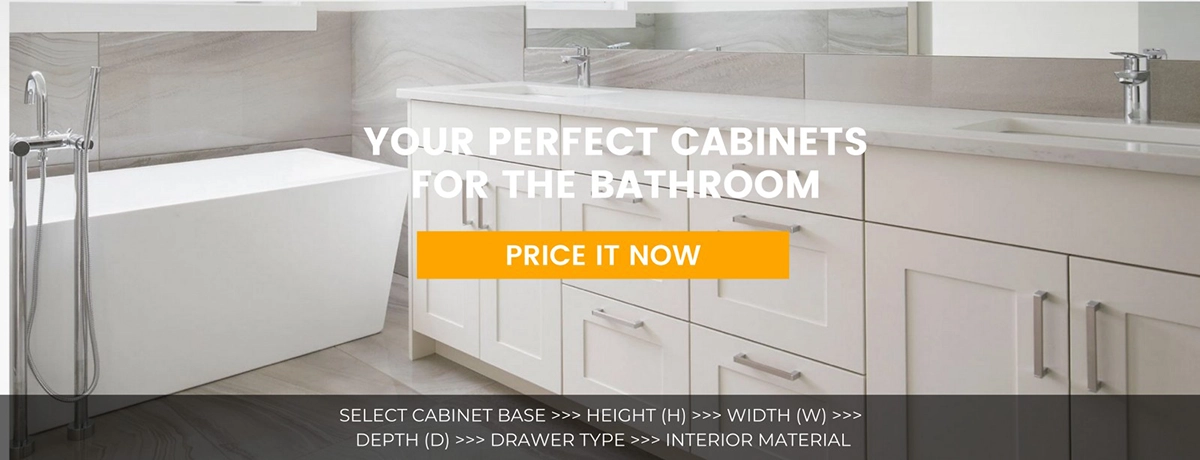What are bathroom vanities made of? Guide on different materials for vanities

When it comes time to replace bathroom cabinets or simply buy new ones after renovation, the first thing that comes to mind is their appearance. You imagine the colour, and shape, dimensions sometimes, but few people think about the best material for bathroom cabinets. It is possible that this underestimation back then led you to the necessity of replacement. Bathrooms are highly used premises, so the materials you apply for your bathroom should be durable and moisture-resistant. This is a hard combination for a bathroom vanity material. But nothing is impossible with modern technologies. Nowadays there are plenty of bathroom vanity designs and materials to choose from.
Durable bathroom vanities are not mandatory to be expensive or custom-made ones. The secret is to do research through the types of vanity materials and find that one suits you best. And that is not obligated to be the best for everyone. You may rely on your budget, personal view or other factors, for instance, selling the house. You may choose a cheap laminated MDF unit to be able to replace it in a few years - just to experiment with a new form. Although you may opt for a built-in natural wood cabinet to be a focal point of your bathroom for decades. All these needs determine your best material for a bathroom vanity.
It is although crucial to design the entire bathroom with cabinet furniture in mind. Given the ability of natural wood to contract and expand in humid environments, you wouldn’t like the idea of painting your wood vanity, as it will reveal paint cracks over time. However, plywood or MDF materials for bathroom cabinets are able to withstand moisture and heat without contracting so they are the best options for painted units.
With all these nuances, it can be daunting to make an informed choice. For this reason, Cut2Size make a comprehensive guide to different types of bathroom vanity materials. We are happy to offer you our best pick and comparison of vanity core materials and their properties.
Best materials for bathroom vanity cabinet
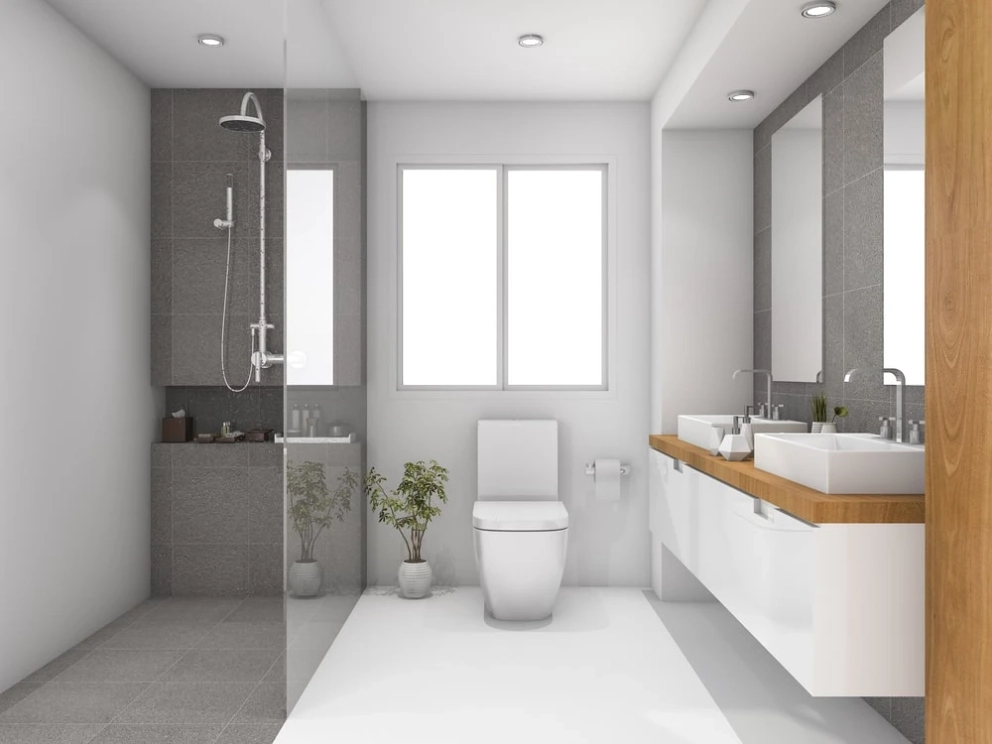
When it comes to the bathroom, a well-crafted vanity cabinet plays a pivotal role in elevating both style and functionality. However, with an overwhelming array of materials for a bathroom to choose from, selecting the perfect one can be a daunting task. In this comprehensive guide, we'll navigate through the top bathroom vanity materials, We’ll break down and compare materials bathroom vanity to help you decide on the best vanity materials bathroom.
| Materials | Definition | Pros | Cons |
| Natural wood | Timeless elegance meets warm allure with natural materials bathroom vanity. From rich oak to luxurious walnut, these bath vanity materials add a touch of nature to your space, creating a soothing relaxing environment. | Classic beauty, durability, and ability to be refinished. Each wood species brings its unique grain patterns, offering a one-of-a-kind vanity. | Vulnerable to water damage if not properly sealed and may require periodic maintenance. |
| Plywood | Plywood bathroom vanity furniture materials combine affordability with sturdiness. Made from layers of wood veneers, they are an excellent budget-friendly option without sacrificing quality. | More water-resistant than solid wood, less prone to warping, and provides a smooth surface for finishes. | Visible edges may require additional finishing touches. |
| Medium-density fiberboard | MDF is engineered from wood fibres and resin, resulting in a stable and budget-conscious choice for bathroom vanity cabinets. It is also considered one of the most common bathroom vanity materials. | Resistant to moisture and cost-effective. It can be easily painted or veneered. | Not as durable as solid wood and may not hold up well against impacts or heavy loads. |
| Stainless steel | Sleek and contemporary, stainless steel bathroom vanity cabinets are perfect for modern, industrial, or minimalist aesthetics. | Resistant to water, stains, and corrosion. Easy to clean and maintain. | Can show fingerprints and scratches, which may not be everyone's preference. |
| Engineered quartz | For countertops, engineered quartz brings luxury and resilience together, making it an increasingly popular bathroom vanity material used in high-end residences. | Non-porous surface resists stains, scratches, and moisture. Available in a wide range of colours and patterns. | Can be relatively heavy and may require professional installation. Opt for this if you are looking for a waterproof cabinet material. |
| Natural stone | For a touch of opulence and unmatched natural beauty, granite and marble vanity countertops remain unparalleled choices. | Each slab is unique, offering exquisite patterns and veining. Highly durable and heat-resistant. | Porous nature requires regular sealing, and marble is more susceptible to etching from acidic substances. |
| Glass | For a touch of elegance and visual lightness, glass vanity countertops create an airy and sophisticated atmosphere. | Non-porous and easy to clean. Available in various tints and textures. | Requires regular cleaning to prevent smudges and water spots. |
| Concrete | Concrete bathroom vanity counters embrace a rugged charm and can be custom-made for a distinctive look. | Exceptionally durable and can be personalized with different finishes and embedded objects. | Prone to stains if not properly sealed, and its weight may necessitate additional support during installation. |
Natural wood bathroom vanities
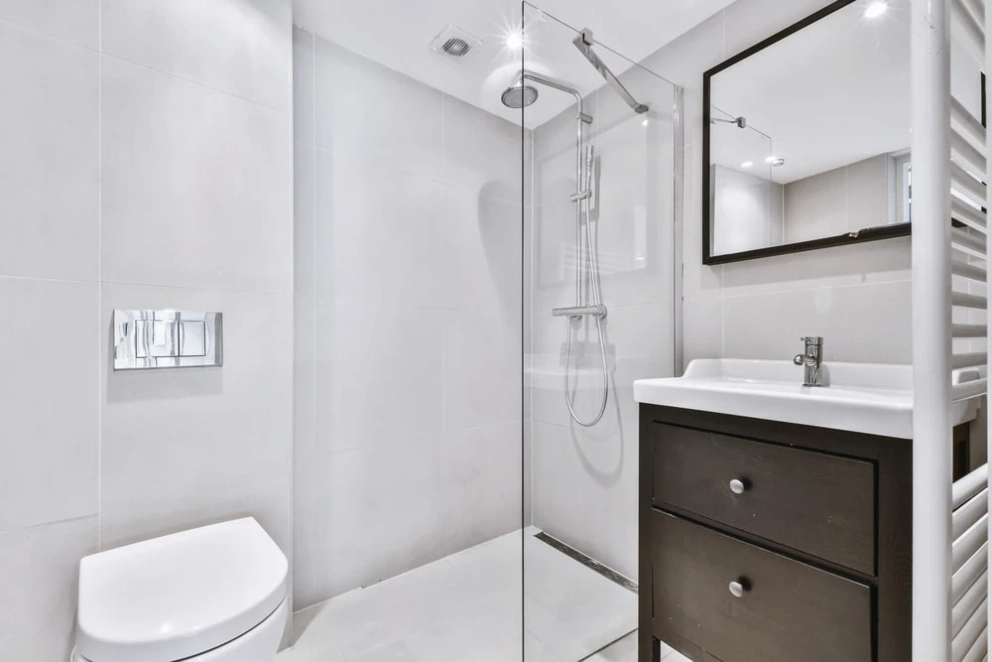
Investing in a natural wood bathroom vanity is a surefire way to infuse your bathroom with elegance, durability and a touch of nature's beauty. Real wood bathroom vanity cabinets offer unique characteristics that cater to different design preferences. From the traditional warmth of cherry wood to the contemporary appeal of mango wood, there's a hardwood bathroom vanity to suit every style and elevate the overall aesthetic of your bathroom space. In this section we’ll talk more about the different types of natural wood cabinets bathroom so you’ll be able to identify and differentiate them.
- Hardwood bathroom vanity
A hardwood vanity bathroom, in general, refers to a bathroom cabinet crafted from any type of hardwood material. Wood cabinets for the bathroom such as hardwood are known for their exceptional strength and durability, making it ideal for furniture pieces that can withstand daily use and humidity exposure. Hardwood slab bathroom vanity often features intricate wood grain patterns and are available in various finishes to complement a wide range of bathroom styles.
- Cherry wood bathroom cabinet
A cherry wood vanity bathroom is renowned for its striking reddish-brown hue and its ability to develop a beautiful patina with age. A cherry wood bathroom vanity exudes warmth and sophistication, making it a popular choice for traditional and transitional bathroom designs. The smooth texture and fine grain of a bathroom with a wood vanity create an exquisite appearance that adds a touch of luxury to any bathroom space.
- Teak wood vanity bathroom
A teak wood bathroom cabinet is prized for its natural oils, making it highly resistant to water and moisture. Teak natural wood bathroom cabinets are an excellent choice for bathrooms because of their ability to withstand humid environments without warping or deteriorating. Additionally, the stunning golden-brown colour and unique grain patterns of a bathroom with a natural wood vanity give the bathroom an organic and earthy feel, perfect for modern and contemporary design themes.
- Oak wood bathroom cabinet
Oak wood is a classic choice for bathrooms with wood vanities because it is renowned for its strength and longevity. Available in various shades, such as white oak and red oak, this type of solid wood bathroom cabinet offers versatile design possibilities, complementing both traditional and modern bathroom aesthetics. Real wood bathroom cabinets' prominent grain patterns and rugged appearance lend a sense of timeless charm to any bathroom space.
- Mango wood bathroom cabinet
Mango wood bathroom vanity cabinet, known for its sustainability and eco-friendliness, has gained popularity in recent years as an attractive material for bathroom vanities. The light brown hue and natural variations in colour of mango wood bathroom furniture create a relaxed and rustic ambiance in the bathroom. Mango wood's distinctive patterns add character to the vanity, making it an eye-catching centrepiece in contemporary and bohemian-style bathrooms.
- Rubber-wood bathroom vanity
Rubberwood bathroom vanities are an excellent choice for those seeking a sustainable and environmentally-friendly option. Rubber wood, also known as Hevea wood, is derived from the rubber tree's plantation after it has completed its latex-producing cycle. Using this resource helps reduce waste and promote eco-consciousness.
Besides its environmental benefits, rubber wood boasts a smooth, attractive surface and a durable composition, making it an ideal material for crafting elegant bathroom vanities that can withstand daily use. Its unique grain patterns and natural warmth add a touch of rustic charm to any bathroom décor, making rubber wood bathroom vanities a stylish and responsible choice for those looking to enhance their bathroom space.
The benefits of natural wood bathroom vanities
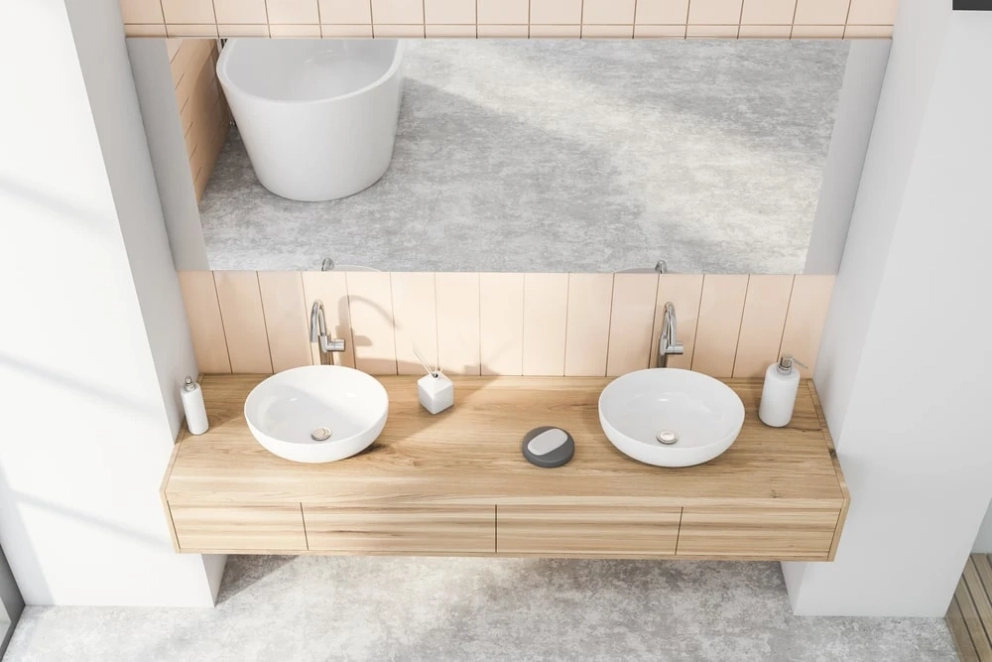
Natural bathroom wood cabinets epitomize the epitome of craftsmanship. Each piece is carefully handcrafted by skilled artisans, showcasing the beauty of natural wood grains and unique patterns. The result is an exquisite piece that exudes elegance, warmth, and a connection to nature that simply cannot be replicated. Here are a few advantages of solid wood bathroom vanities:
- Durability and longevity
One of the primary benefits of solid wood vanity for a bathroom is its exceptional durability and longevity. High-quality woods like oak, maple, cherry, teak, and walnut are commonly used in crafting these vanities. These solid wood bathroom vanity cabinets possess inherent sturdiness, ensuring your vanity withstands daily wear and tear, making it a long-term investment for your bathroom.
- Eco-friendly and sustainable
Opting for a natural wood vanity bathroom vanity aligns with eco-conscious living. Many manufacturers adhere to sustainable practices, sourcing the best wood for bathrooms from responsibly managed forests or utilizing reclaimed wood, reducing environmental impact and promoting the conservation of natural resources.
- Aesthetic versatility
A solid wood vanity cabinet boasts an array of shades and finishes, allowing you to customize your vanity to match your personal taste and decor preferences. From light hues of ash or pine to rich, dark tones of mahogany or walnut, there's the best wood for the bathroom vanity to complement every bathroom style.
- Moisture resistance
Contrary to common misconceptions, well-sealed bathroom vanities of solid wood can be remarkably resistant to moisture. Properly treated solid wood bathroom vanity is less susceptible to water damage and warping, making it an ideal choice for bathroom environments.
Caring for your natural wood bathroom vanity
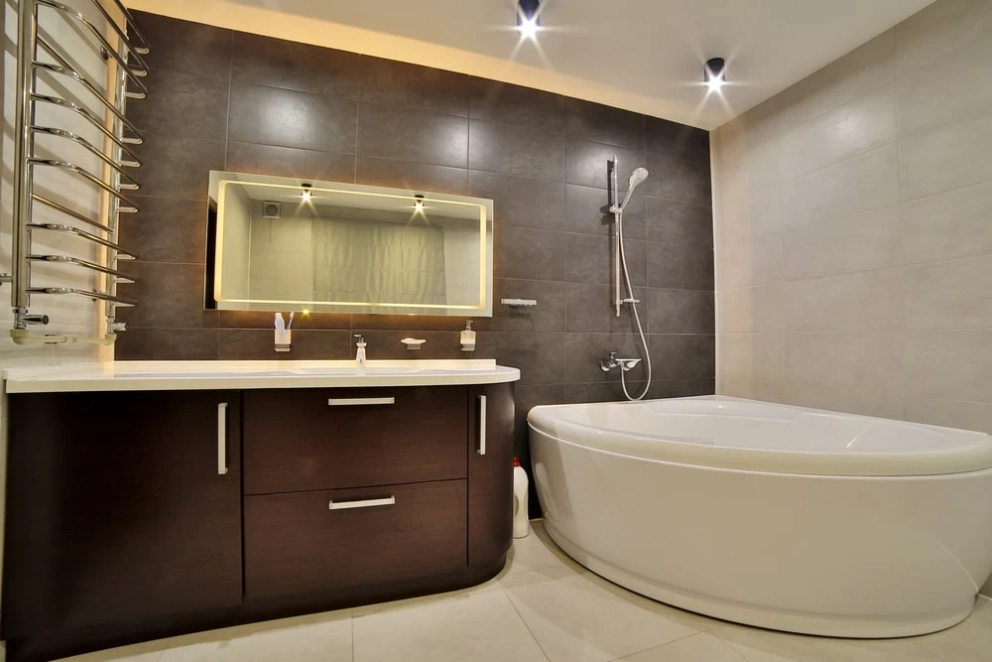
A well-crafted natural wood vanity exudes warmth, sophistication, and a connection to nature that enhances the overall ambiance of your bathroom. However, with this beauty comes responsibility - caring for your wooden vanity requires a delicate balance between preservation and practicality.
- Regular cleaning
To maintain the lustre of solid wood bathroom vanities, clean them regularly with a soft cloth or sponge and mild soapy water. Avoid harsh chemical cleaners that could damage the solid wood bath vanity or strip away its protective finish.
- Avoid excessive moisture exposure
While solid wood vanity cabinets can resist moisture, it is essential to minimize prolonged exposure to standing water or excessive humidity. Promptly wipe away any water spills and ensure proper ventilation in your bathroom.
- Seasonal maintenance
Solid wood bathroom cabinets are sensitive to fluctuations in humidity, which can cause them to expand or contract. To prevent cracks or warping in your solid wood bathroom cabinet, consider using a humidifier during dry winter months and a dehumidifier in humid climates.
- Re-sealing
Over time, the protective sealant on your wood vanity may wear down. To maintain its integrity, consider re-sealing your vanity every couple of years or as needed. Always follow the manufacturer's guidelines for appropriate sealant products.
Choosing the right natural wood vanity for your bathroom
Unlike trends that come and go, bathroom cabinet wood has an enduring appeal that transcends time. Whether your bathroom decor is traditional, rustic, modern, or eclectic, bathroom cabinets from solid wood blend seamlessly with any style, making it a versatile and classic choice. When choosing the best wood for bathroom vanities, take note of these three important factors.
- Size and layout
Consider the available space in your bathroom and the layout before selecting a real wood vanity bathroom. Measure the area precisely, including door openings and clearances, to ensure a perfect fit.
- Storage needs
Assess your storage requirements and opt for real wood bathroom vanities that offer sufficient drawers and cabinets to keep your bathroom essentials organized and easily accessible.
- Style and design
Choose a wood vanity that complements the existing decor of your bathroom. Whether you prefer a sleek, modern design or a more ornate and traditional style, there's a wood vanity to match your preferences.
Plywood vanity cabinets
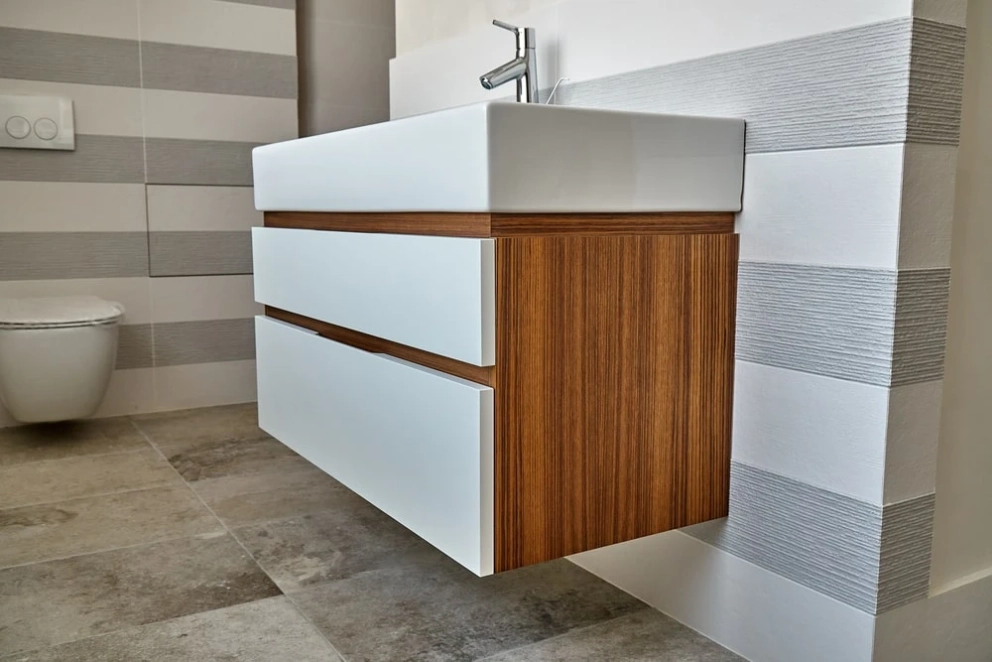
Plywood bathroom cabinets are durable and moisture-resistant bathroom storage solutions made from bonded wood veneers. A bathroom vanity plywood offers several advantages, including high strength and resilience due to cross-grain construction, making it less prone to warping and cracking.
With various designs and finishes available, homeowners can easily find a plywood bathroom cabinet that complements their bathroom decor. Plywood bathroom vanities are cost-effective compared to solid wood options, making them a budget-friendly choice without sacrificing quality.
However, some types of plywood for bathroom vanity may not be entirely waterproof, so proper maintenance and ventilation are crucial to avoid water damage. While some buyers may prefer the consistent appearance of solid wood, a plywood bathroom vanity remains a popular and eco-friendly option for stylish and practical bathroom storage.
Plywood bathroom cabinets pros and cons:
| Pros | Cons |
| Strength and durability. Plywood cabinets are robust and resilient, with cross-grain construction that minimizes warping and cracking, ensuring long-lasting performance in the bathroom. | Vulnerable to water damage. While plywood is moisture-resistant, prolonged exposure to standing water or high humidity can still cause damage, such as delamination or warping. |
| Moisture resistance. These cabinets have natural moisture-resistant properties, making them suitable for humid bathroom environments. | Appearance variability. The grain patterns of the plywood vanity bathroom may not be as consistent or uniform as solid wood, potentially affecting the overall appearance of the cabinets. |
| Versatility. Plywood bathroom cabinets come in various designs, styles, and finishes, offering a wide range of options to complement different bathroom decors. | Exposed edges. The exposed edges of plywood cabinets can be susceptible to wear and damage over time, necessitating edge banding or selecting cabinets with solid wood frames. |
| Cost-effective. Plywood is more affordable than solid wood, making it a cost-effective choice for budget-conscious homeowners. | Resale value. In certain real estate markets, plywood bathroom vanity cabinets may have lower resale value compared to solid wood, which is often considered a premium feature. |
| Easy to modify. Plywood is easy to customize, allowing for adjustments to fit specific bathroom layouts or drilling holes for fixtures. | - |
| Eco-friendly. Plywood bathroom vanities are considered more environmentally friendly, being made from renewable resources and requiring less energy in production compared to other materials. | - |
Despite these drawbacks, plywood bathroom cabinets remain a popular and practical choice for their balance of strength, cost-effectiveness, and aesthetic appeal, with proper maintenance ensuring their durability and functionality in bathrooms.
MDF bathroom vanities
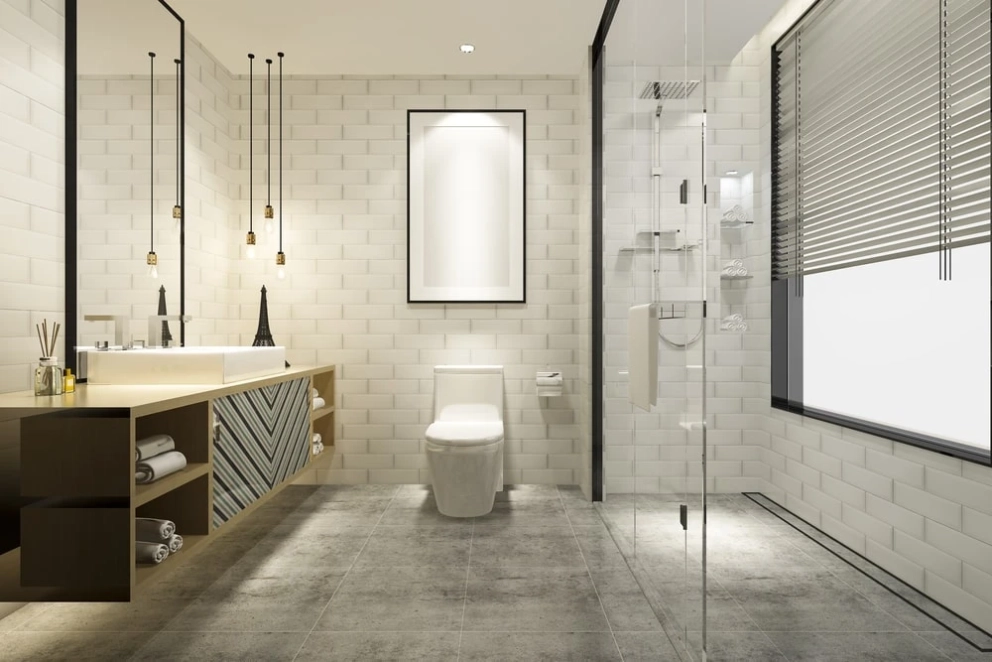
An MDF bathroom vanity has gained widespread popularity due to its blend of elegance and practicality. Made from Medium-Density Fiberboard or engineered wood, these bathroom vanity fixtures offer a smooth surface for intricate designs and a variety of finishes to match any bathroom style. They boast water resistance when properly treated and sealed, ensuring their longevity and suitability for the bathroom environment. The design versatility, and eco-friendly nature of MDF vanity bathroom make it an attractive choice for those seeking a cost-effective and sustainable bathroom upgrade.
In comparison to particle board bathroom vanities, MDF for bathroom vanity proves to be the superior option. The higher density and increased durability of the MDF bathroom cabinet make it less susceptible to damage from everyday use, while its moisture resistance outperforms standard particle board, reducing the risk of swelling over time. With proper maintenance, including wiping off spills promptly and using gentle cleaning agents, a particle board vanity bathroom can maintain its attractiveness and functionality for years to come, providing a stylish and practical addition to any modern bathroom setting.
Laminate bathroom vanity
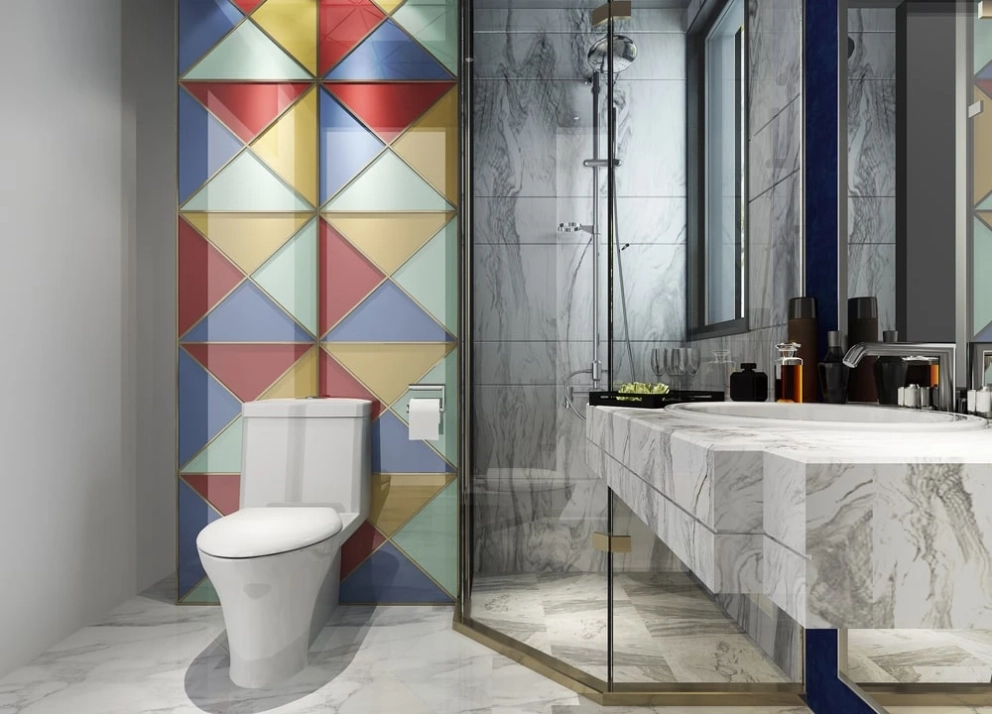
A bathroom vanity laminate offers a myriad of features and characteristics that make it a popular and practical choice for modern bathrooms. These vanities are constructed using a synthetic material, typically high-pressure laminate, which is applied to a wood or MDF core. The laminate surface provides excellent water resistance, making it highly suitable for the bathroom environment. It comes in a wide array of colours, patterns, and textures, allowing for endless design possibilities to match various interior styles. Laminate bathroom vanities are known for their affordability, easy maintenance, and durability, as they can resist stains, scratches, and fading. With their versatility, practicality, and visually appealing finishes, laminate bathroom vanities offer an ideal blend of style and functionality for any bathroom upgrade.
Summarizing the key points
When selecting bathroom vanity materials, it is essential to consider several key factors, including aesthetics, durability, maintenance, and budget. Aesthetics play a crucial role in matching the vanity with your bathroom's overall design and style. Durability is essential as the vanity needs to withstand daily use and potential exposure to moisture.
Easy maintenance is another aspect to consider, ensuring that the chosen material can be kept clean and in good condition without much effort. Finally, the budget should be taken into account to find a material that meets both your design preferences and financial constraints. By carefully evaluating these factors, you can make an informed decision and find the perfect bathroom vanity material that combines both form and function.
